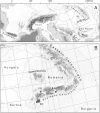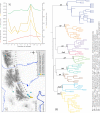Southern Carpathian ultramafic grasslands within the central-southeast European context: syntaxonomic classification and overall eco-coenotic patterns
- PMID: 36222902
- PMCID: PMC9556682
- DOI: 10.1186/s40529-022-00355-8
Southern Carpathian ultramafic grasslands within the central-southeast European context: syntaxonomic classification and overall eco-coenotic patterns
Erratum in
-
Correction: Southern Carpathian ultramafic grasslands within the central-southeast European context: syntaxonomic classification and overall eco-coenotic patterns.Bot Stud. 2022 Nov 21;63(1):32. doi: 10.1186/s40529-022-00362-9. Bot Stud. 2022. PMID: 36409437 Free PMC article. No abstract available.
Abstract
Background: Previous investigations carried out in ultramafic habitats emphasized the greater importance of site conditions over soil toxic metal content for vegetation composition. Very little is known about the floristic structure of the Southern Carpathian ultramafic grasslands and there is no information on the local environmental drivers of their composition and coenotic features. Here, we aim to fill these knowledge gaps by referring to similar phytocoenoses described in the Balkan Peninsula and central Europe. In particular, we searched for: (i) floristic and ecological patterns supporting the classification and taxonomic assignment of these grasslands, and (ii) simple relationships between serpentine vegetation characteristics and its physiographic environment. A total of 120 phytosociological relevés, of which 52 performed in the Southern Carpathians, were analysed through cluster, ordination and regression procedures.
Results: Despite some floristic similarities with their Balkan counterparts, the Southern Carpathian ultramafic grasslands were clustered into four distinct groups, which were assigned to as many new syntaxa: Plantago serpentinae-Armerietum halleri, Asplenio serpentini-Achnatheretum calamagrostis, Minuartio frutescentis-Plantaginetum holostei and Sileno saxifragae-Plantaginetum holostei. The latter was best individualised through the occurrence of several Carpathian endemic taxa. The first two ordination axes were significantly related with the terrain slope/presence of xerophilous species and respectively, with site elevation/presence of calcifugous species. The total plant cover showed a unimodal relationship with respect to site elevation. While controlling for the effect of the sampled area, species richness showed a unimodal response to both elevation and slope of the terrain, although their effects were not singular.
Conclusions: The syntaxonomic distinctiveness of the Southern Carpathian ultramafic grasslands is mainly supported by their overall species composition rather than regional differential species. The main limiting factors driving the composition, cover and species richness of all studied ultramafic grasslands are the water deficit at low elevation and on steep slopes, and the low soil fertility at higher elevations. Our results confirm the previous findings according to which physiographic conditions and, to a lesser extent, soil base nutrients are more important than heavy metal concentrations in structuring the ultramafic vegetation.
Keywords: Balkan Peninsula; Elevation; Heavy metals; New syntaxa; Serpentine habitats; Soil pH; Southern Carpathians; Species richness; Terrain slope; Vegetation cover.
© 2022. The Author(s).
Conflict of interest statement
The authors declare that they have no competing interests.
Figures




References
-
- Aćić S, Šilc U, Petrović M, Tomović G, Dajić Stevanović Z. Classification, ecology and biodiversity of Central Balkan dry grasslands. Tuexenia. 2015;35:329–353.
-
- Alexander EB, DuShey J. Topographic and soil differences from peridotite to serpentinite. Geomorphology. 2011;135:271–276. doi: 10.1016/j.geomorph.2011.02.007. - DOI
-
- Alexander EB, Coleman RG, Keeler-Wolf T, Harrison S. Serpentine geoecology of western North America. New York: Oxford University Press; 2007.
-
- Baker AJM, Proctor J, Reeves RD. The vegetation of ultramafic (serpentine) soils. Dordrecht: Kluwer Academic Publishers; 1992.
-
- Batianoff NG, Singh S. Central Queensland serpentine landforms, plant ecology and endemism. S Afr J Sci. 2001;97:495–500.
LinkOut - more resources
Full Text Sources

